Today, the spotlight is likely to fall on the US CPIs for March, with both the headline and core rates expected to have continued drifting north, something that could add more credence to the view that the Fed may need to proceed with larger than quarter-point rate increments in the months to come. Tonight, during the early Asian session, the RBNZ decides on interest rates, and although a hike is a done deal, the question is whether it will be 25 bps or 50.
Will the Cpis Cement the Case for Double Hikes by the Fed
The US dollar traded higher against most of the other major currencies on Monday and during the Asian session Tuesday. It underperformed only against CHF, while it was found virtually unchanged against GBP. The greenback gained the most versus CAD, AUD, and JPY, in that order.
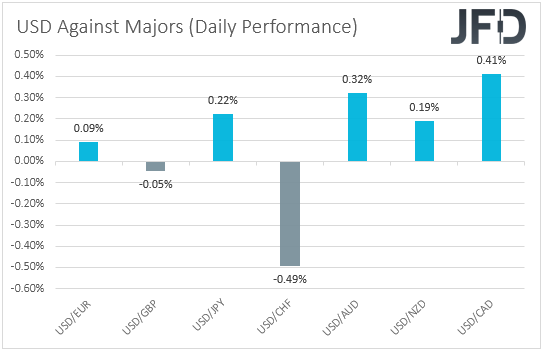
The strengthening of the US dollar and the Swiss franc, combined with the weakening of the risk-linked Loonie and Aussie, suggests that financial markets may have traded in a risk-off manner yesterday and today in Asia.
Only the weakening of the yen points otherwise. Indeed, turning our gaze to the equity world, we see that most major EU indices traded in the red, with the negative appetite intensifying during the US session. It improved partially during the Asian session today.
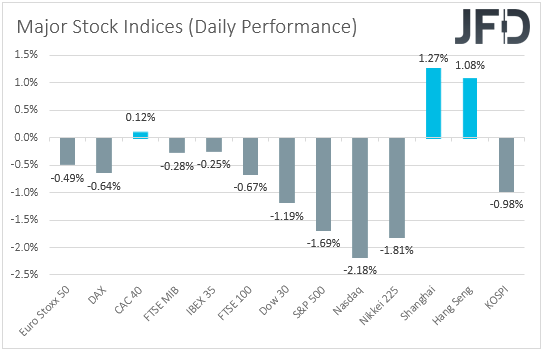
Investors may have continued reducing their risk exposures on fears that the Fed may proceed with an even more aggressive rate path than projected in the last “dot plot,” which is supported by the rise in Treasury yields.
With that in mind, today, the spotlight is likely to fall on the US CPIs for March. Both the headline and core rates are forecast to have continued rising, despite the Fed and other major central banks around the world beginning a normalization process.
Specifically, the headline rate is anticipated to have risen to +8.4% YoY from +7.9%, while the core one is anticipated to have inched up to +6.6% YoY from +6.4%.
At the last FOMC gathering, the Committee hiked interest rates by 25 bps for the first time since 2018, with the updated “dot plot” pointing to 6 more quarter-point increases until the end of the year. This means one liftoff at each of the remaining gatherings for 2022.
That said, since then, Fed officials, including Fed Chair Jerome Powell, appeared even more hawkish, noting that they could use larger liftoffs if needed, something also confirmed by the minutes of the last meeting, released last week.
According to the CME FedWatch Tool, investors are now pricing in an 84.3% chance for a double hike at the upcoming meeting, scheduled for May 4. They assign a 55.5% probability for another double increase in June.
They even see a 35.5% likelihood for a 75bps increase in June. Thus, following another strong employment report around ten days ago, further acceleration in inflation could add credence to the view of very aggressive tightening by the Fed and may push the US dollar higher. At the same time, equities are likely to continue correcting south.
NASDAQ 100 – Technical Outlook
The NASDAQ 100 cash index continued drifting south yesterday, breaking below the 14185 barrier marked by the low of Mar. 21. Overall, the index has been in a short-term downtrend after it reversed south by completing a failure swing top on Apr. 6. The short-term downtrend is marked by a downside line taken from the peak of Apr. 5.
At the time of writing, the cash index looks to be headed towards the low of Mar. 17, at 13825, the break of which could invite more bears and perhaps pave the way towards the low of the day before, at around 13460. If that barrier doesn’t hold, its break could carry larger bearish implications, perhaps paving the way towards the 13020 or the 12945 zones, marked by the lows of Feb. 24 and Mar. 15, respectively.
On the upside, we will start examining the case of a decent recovery upon a break above 14185. This could confirm the break above the aforementioned downside line and encourage advances towards the 14450 zone, marked by the lows of Mar. 24 and 25.
If the bulls are unwilling to stop there, we may see them marching towards the 14635 level or the 14795 zone, marked by the high of Apr. 8 and the inside swing low of Apr. 1, respectively.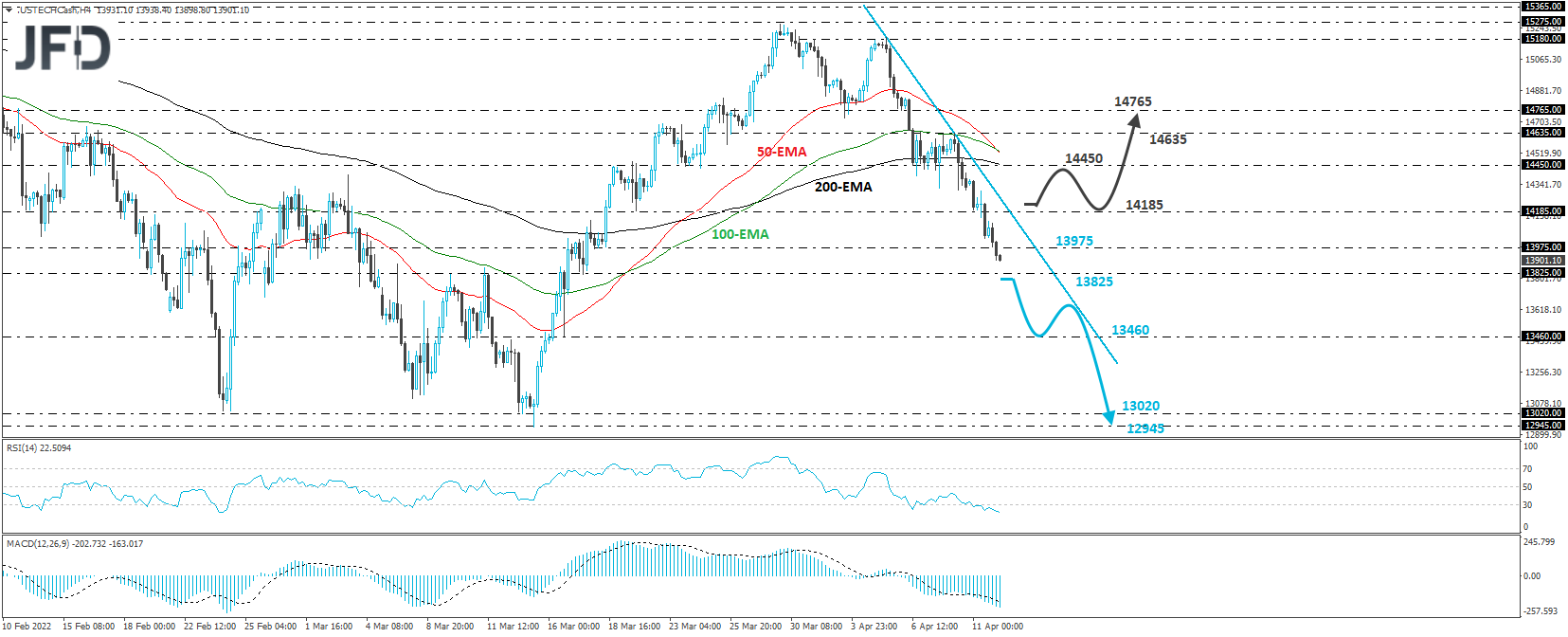
Will the RBNZ Hike by 25 or 50 bps?
Tonight, during the Asian session Wednesday, we have a central bank deciding on its interest rates, and this is the RBNZ. When they last met, officials of this bank decided to push the hike button for the third straight meeting, lifting interest rates by another 25 bps to 1%.
The bank also steepened its rate-path projections, with officials projecting that the OCR will hit 3.35% by the end of 2024, instead 2.6% predicted in November. For the end of this year, they see the rate being lifted to 2.5%, a quarter-point higher than the 2.25% seen in November.
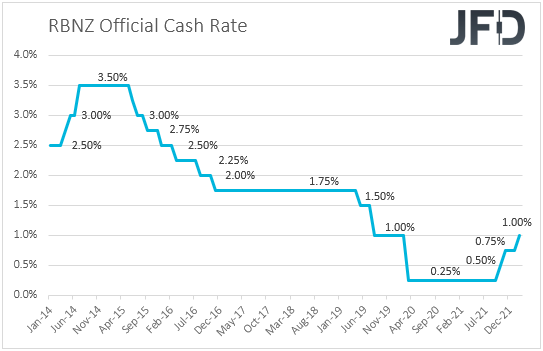
The bank is expected to continue lifting rates by another 25 bps at this gathering, but some participants call for a half-point increase to +1.50%. This is because supply chain disruptions and a tight labor market have pushed inflation up to a three-decade high of +5.9% YoY in the last quarter of 2021.
Remember that the target range of the RBNZ is between 1 and 3%. That’s double the upper bound. Having said all that, though, we have yet to receive inflation data for the first quarter of this year. Thus, we believe that policymakers will proceed with the expected 25bps increase until they have concrete evidence as to whether more is needed.
Therefore, a 25 bps increase is unlikely to move the New Zealand dollar. For the Kiwi to rebound, this needs to be accompanied by an even more hawkish language than previously, pointing to an even faster rate hike.
Now, if the narrative is more or less the same as last time, the currency is likely to slide, especially against its US counterpart, bearing in mind the expectations of a very aggressive Fed. The third scenario, and the one that carries the least likely in our view, and consequently the biggest element of surprise, is a double hike. This could result in a stronger and longer rebound than in the case of just a hawkish language.
NZD/USD – Technical Outlook
NZD/USD consolidated yesterday and today in Asia after breaking below the upside support line drawn from the low of Jan. 28. We will abandon the bullish case and turn neutral with that in mind. We will start examining the completion of a bearish reversal upon a dip below 0.6795, support marked by the low of Mar. 9.
This would confirm a forthcoming lower low on the 4-hour chart and may pave the way towards the 0.6727/40 area, marked by the lows of March 15th and 16th, respectively. Another break, below 0.6727, could see scope for more declines, perhaps towards the low of Feb. 27, at 0.6675, or even the low of Feb. 24, at 0.6630.
We will start examining the resumption of the prevailing uptrend upon a break back above the 0.6900 zone, marked by the low of Apr. 1. This may encourage the bulls to climb towards the 0.6965 hurdle, marked by the peak of Apr. 6, the break of which could carry extensions towards the peak of the day before, at around 0.7035.
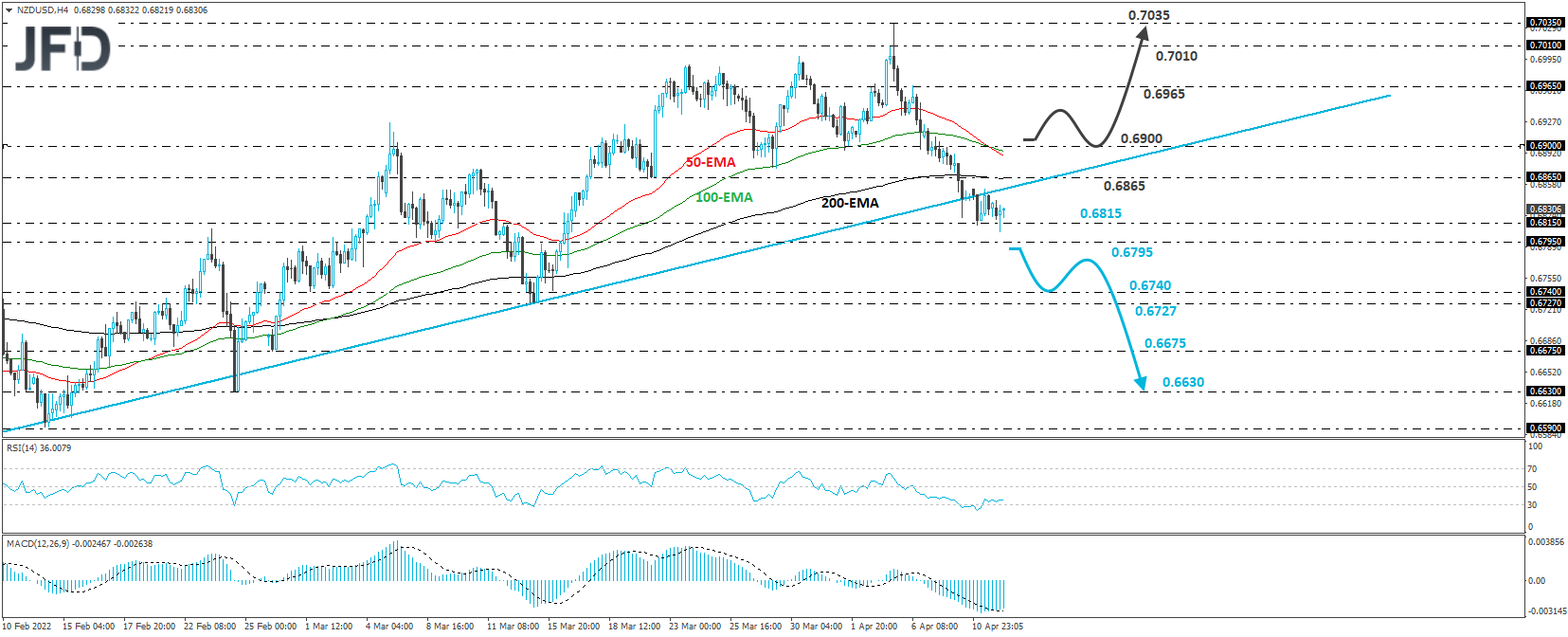
As for the Rest of Today’s Events
We already got the UK employment report for February during the early EU session. The unemployment rate ticked down to 3.8% from 3.9%, while the net change in employment showed that the economy had gained 10k jobs after losing 12k in January. The forecast was for a 50k gain.
The German ZEW survey for April came out, with both the current conditions and expectations indices falling lesser than was expected. As for tomorrow, a few hours after the RBNZ decision, we get the UK CPIs for March, with both the headline and core rates expected to have continued drifting north.
At their last gathering, BoE officials decided to hike interest rates by another 25 bps via an 8-1 voting, with the dissenter calling for no increase. Remember that officials lifted rates by 25 bps at the February gathering, but the vote was 5-4, with the dissenters calling for a 50 bps increase.
Compared to that, March’s decision revealed a more cautious approach by policymakers and raised questions as to whether they will indeed proceed as aggressively as the market has been pricing in heading into the gathering.
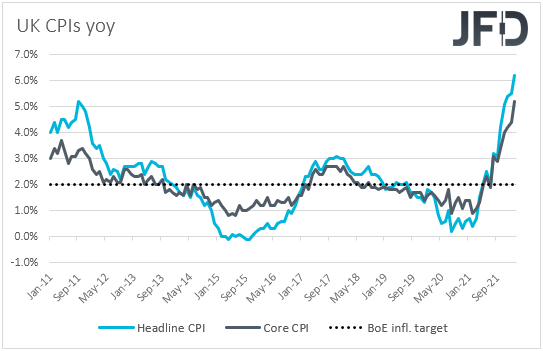
With inflation accelerating in February and expected to continue so in March, market participants are likely to stay convinced that the BoE may need to act more quickly, supporting the British pound, especially against the Japanese yen.
Remember that the BoJ has pledged to keep its policy extra loose when other major central banks are in a race of tightening. This monetary policy divergence is likely to continue weighing on the Japanese currency.
